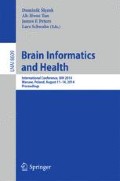Abstract
Spike sorting is often required for analyzing neural recordings to isolate the activity of single neurons. In this paper, a new feature extractor based on Wavelet and kernel PCA for spike sorting was proposed. Electrophysiology recordings were made in Sprague-Dawley (SD) rats to provide neural signals. Here, an adaptive threshold based on the duty-cycle keeping method was used to detect spike and a new spike alignment technique was used to decrease sampling skew error. After spikes were detected and alimented, to extract spike features, their wavelet transform was calculated, the first 10 coefficients with the largest deviation from normality provided a compressed representation of the spike features that serves as the input to KPCA algorithm. Once the features have been extracted, k-means clustering was utilised to separate the features and differentiate the spikes. Test results with simulated data files and data obtained from SD rats in vivo showed an excellent classification result, indicating the good performance of the described algorithm approach.
Access this chapter
Tax calculation will be finalised at checkout
Purchases are for personal use only
Preview
Unable to display preview. Download preview PDF.
References
Pedreira, C., Martinez, J., Ison, M.J., Quiroga, R.Q.: How many neurons can we see with current spike sorting algorithms? Journal of Neuroscience Methods 211, 58–65 (2012)
Musial, P.G., Baker, S.N., Gerstein, G.L., King, E.A., Keating, J.G.: Signal-to-noise ratio improvement in multiple electrode recording. J. Neurosci. Methods 115, 29–43 (2002)
Paraskevopoulou, S.E., Barsakcioglu, D.Y., Saberi, M.R., Eftekhar, A., Constandinou, T.G.: Feature extraction using first and second derivative extrema (FSDE) for real-time and hardware-efficient spike sorting. Journal of Neuroscience Methods 215, 29–37 (2013)
Quiroga, R.Q., Nadasdy, Z., Ben-Shaul, Y.: Unsupervised Spike Detection and Sorting with Wavelets and Superparamagnetic Clustering. Neural Comput 16(8), 1661–1687 (2004)
Lewicki, M.: A review of methods for spike sorting: The detection and classification of neural action potentials. Network: Comput. Neural Syst. 9, 53–78 (1998)
Jung, H.K., Choi, J.H., Kim, T.: Solving alignment problems in neural spike sorting using frequency domain PCA. Neurocomputing 69, 975–978 (2006)
Bar-Hillel, A., Spiro, A., Stark, E.: Spike sorting: Bayesian clustering of non-stationary data. Journal of Neuroscience Methods 157, 303–316 (2006)
Kirn, K.H., Kirn, S.J.: A wavelet-based method for action potential detection from extracellular neural signal recording with low signal-to-noise ratio. IEEE Transactions on Biomedical Engineering 50(8), 999–1011 (2003)
Calabrese, A., Paninski, L.: Kalman filter mixture model for spike sorting of non-stationary data. Journal of Neuroscience Methods 196, 159–169 (2011)
Abeles, M., Goldstein, M.H.: Multispike train analysis. Proc. IEEE 65, 762–773 (1997)
Adamos, D.A., Kosmidis, E.K., Theophilidis, G.: Performance evaluation of PCA-based spike sorting algorithms. Computer Methods and Programs in Biomedicine 91, 232–244 (2008)
Scholkopf, B., Smola, A.J., Muller, K.: Nonlinear component analysis as a kernel eigenvalue problem. Neural Computation 10(5), 1299–1399 (1998)
Romdhani, S., Gong, S., Psarrou, A.: A multi-view nonlinear active shape model using kernel PCA. In: Proceedings of BMVC, Nottingham, UK, pp. 483–492 (1999)
Choi, S.W., Lee, I.-B.: Nonlinear dynamic process monitoring based on dynamic kernel PCA. Chemical Engineering Science 59, 5897–5908 (2004)
Mika, S., Scholkopf, B., Smola, A.J., Muller, K.-R., Scholz, M., Ratsch, G., Kernel, P.C.A.: de-noising in feature spaces. Advances in Neural Information Processing Systems 11, 536–542 (1999)
Scholkopf, B., Smola, A.J., Muller, K.: Nonlinear component analysis as a kernel eigenvalue problem. Neural Computation 10(5), 1299–1399 (1998)
Harrison, R.R.: A low-power integrated circuit for adaptive detection of action potentials in noisy signals. In: Proceedings of the 25th International IEEE EMBS Conference, pp. 3325–3328. IEEE, Cancun (2003)
Chen, Y.-Y., Chen, T.-C., Chen, L.-G.: Accuracy and power tradeoff in spike sorting microsystems with cubic spline interpolation. In: Proceedings of 2010 IEEE International Symposium on Circuits and Systems (ISCAS), pp. 1508–1511 (June 2010)
Müller, K.R., Mika, S., Rtsch, G., Tsuda, K., Schlkopf, B.: An introduction to kernel-based learning algorithms. IEEE Transactions on Neural Networks 12, 181–201 (2001)
Smola, A.J., Scholkopf, B.: Sparse greedy matrix approximation for machine learning. In: Proceedings of ICML 2000, San Francisco, pp. 911–918 (2000)
Song, Y., Lin, N., Liu, C., Luo, J., Wang, L., Cai, X.: Design and Fabrication of Microelectrode Array Sensor for Electrophysiological Recording In Vitro. Nanotechnology and Precision Engineering 9(3), 184–188 (2011)
Song, Y., Lin, N., Liu, C., Jiang, H., Xing, G., Cai, X.: A novel dual mode microelectrode array for neuroelectrical and neurochemical recording in vitro. Biosensors and Bioelectronics 38(1), 416–420 (2012)
Author information
Authors and Affiliations
Editor information
Editors and Affiliations
Rights and permissions
Copyright information
© 2014 Springer International Publishing Switzerland
About this paper
Cite this paper
Liu, JT., Xu, SW., Zhou, JY., Wang, MX., Lin, NS., Cai, XX. (2014). A Novel Feature Extractor Based on Wavelet and Kernel PCA for Spike Sorting Neural Signals. In: Ślȩzak, D., Tan, AH., Peters, J.F., Schwabe, L. (eds) Brain Informatics and Health. BIH 2014. Lecture Notes in Computer Science(), vol 8609. Springer, Cham. https://doi.org/10.1007/978-3-319-09891-3_11
Download citation
DOI: https://doi.org/10.1007/978-3-319-09891-3_11
Publisher Name: Springer, Cham
Print ISBN: 978-3-319-09890-6
Online ISBN: 978-3-319-09891-3
eBook Packages: Computer ScienceComputer Science (R0)

